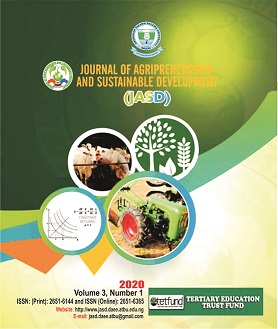AGRICULTURAL CREDIT POLICY IN NIGERIA: PROSPECTS AND CHALLENGES
DOI:
https://doi.org/10.59331/jasd.v3i1.104Keywords:
Agricultural Credit, Incentives, Policies, Programmes, RiskAbstract
The paper reviewed the prospects and challenges of agricultural credit policies in Nigeria. Agricultural credit plays an important role in the agricultural sector of Nigerian economy. Agricultural credit enhances productivity, promotes standard of living and gives absolute support to Agri-business enterprises. It is in recognition of the role of credit in agricultural production that the Nigerian government has over the years formulated agricultural credit policies, programmes and institutions meant to encourage food production and better the lives of farmers. These agricultural credit policies, programmes and institutions are highlighted and discussed. The role of credit in agricultural development is crucial and its constraints can affect farmer’s investment behaviour. It is found that loan beneficiaries often obtained more farm income than non-beneficiaries. Generally, small scale farmer’s low access to credit facility was found to be due to the requirements for collateral, bureaucratic bottlenecks by financial institutions and the perceived high risk and uncertainty of agricultural production. The paper recommended that since farmers constitute majority of the population of Nigeria, government should give special attention to farmers through the provision of special incentives and allocation on credit, policies geared toward diversification of agricultural credit activities should be encouraged in order to minimize risk and uncertainties also Bank personnel should be given special training to ease loan acquisition by rural farmers and supervision so as to avoid loan default.
Downloads

Downloads
Published
How to Cite
Issue
Section
License
Copyright (c) 2022 Journal of Agripreneurship and Sustainable Development

This work is licensed under a Creative Commons Attribution 4.0 International License.






